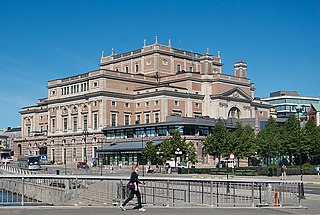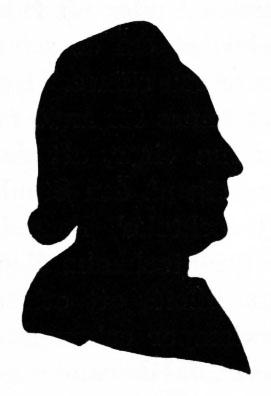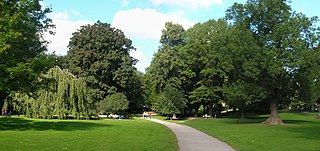
The Royal Swedish Ballet is one of the oldest ballet companies in Europe. Based in Stockholm, Sweden, King Gustav III founded the ballet in 1773 as a part of his national cultural project in response to the French and Italian dominance in this field; he also founded the Royal Swedish Opera and the Royal Dramatic Theatre. All of these were initially located in the old theatre of Bollhuset. The troupe was founded with the opening of the Royal Swedish Opera, which has served as its home since that time.

Bollhuset, also called Stora Bollhuset, Bollhusteatern, and Gamla Bollhuset at various times, was the name of the first theater in Stockholm, Sweden; it was the first Swedish theater and the first real theater building in the whole of Scandinavia. It was built in 1627 for ball sports and used in this way for forty years. The name Lejonkulan, however, was, in fact, the name of a different building, which was also used by the same theater in the 17th century.
Margaret(h)a Seuerling née Lindahl (1747–1820) was a Swedish actress and theatre director in a travelling theatre company, perhaps the most known travelling actress of her time in Scandinavia, active in both Sweden and Finland. She was one of the first, perhaps the very first, to introduce secular theatre in Finland: her family and its company represents a large part of the theatre history in Sweden and Finland.

Petter Stenborg was a Swedish stage actor and theater director. He was the director of the Stenborg Company or Svenska Comoedi-truppen from 1758 onward and as such the director of the Humlegårdsteatern (1773–80) in Stockholm. Petter Stenborg played an important role in Swedish theater history: he was a member of the pioneer actors of the first Swedish national stage in Bollhuset, and as the leader of the Stenborg theatre company, one of only two professional Swedish language theater companies active in the mid 18th-century, he kept professional Swedish language theater alive from the closure of the public theater in Bollhuset in 1754, until the inauguration of the Royal Swedish Opera (1773) and Royal Dramatic Theatre (1788).

Inga Åberg was a Swedish actress and opera singer. She was engaged as an opera singer at the Royal Swedish Opera, and as a stage actress at the Royal Dramatic Theatre, between 1787 and 1810.

Louis Joseph Marie Deland was a Swedish ballet dancer, singer, actor, choreographer and ballet master in the Royal Swedish Ballet. He is often considered the first native male star in the Royal Swedish Ballet.

Louis Gallodier was a French ballet dancer and choreographer who spent the majority of his career in Sweden, where he was to have a great importance for the development of the ballet in Sweden as the ballet master of the Royal Swedish Ballet.

Charles Langlois (1692–1762) was a French actor who spent a large part of his career in Sweden, where he was to play an important part in Swedish theatre history as the originator of the first national theatre in Sweden, and its first director. He was also a composer.
The Stenborg theatre, also called Svenska Komiska Teatern, Komiska Teatern and Munkbroteatern, was a historical Swedish 18th century theatre, active between 1784 and 1799 in Gamla stan in Stockholm. It was the second theatre of Stockholm during the Gustavian age. In 1784-87, before the inauguration of the theatre of Ristell in Bollhuset, it was the only dramatic theatre of the native language in Stockholm.
Marie Baptiste née Dumont or Du Mont was a French stage actress and singer. She is most known for her career in Sweden, where she was a leading member of the French Theatre in the mid 18th-century.
Marguerite Du Londel or Dulondel was a French ballerina, actress and singer (soprano). She was active in the French theater in Sweden and at that time attracted great fame. She is also known for her relationship with king Adolf Frederick of Sweden.

The Stenborg Company was a Swedish Theatre Company, active in Sweden and Finland in the 18th century. It was also called Stenborgska skådebanorna, Svenska komeditruppen and Svenska Comedien ('Swedish Comedy') or Svenska Teatern. It is one of the most famous theatre troupes in its country's history. In the period of 1754–1773, between the closure of the first national Swedish theatre in Bollhuset and the foundation of the next, The Royal Swedish Opera and the Royal Dramatic Theatre, it was the only Theatre performing in the native language in Stockholm. It also has an importance for the history of Finland, being the first professional secular theatre troupe in this country. It was a traveling troupe in 1756–80 and then housed in several buildings.

Carl Stenborg was a Swedish opera singer, composer and theatre director. He belonged to the pioneer generation of the Royal Swedish Opera and was regarded as one of the leading opera singers of the Gustavian era. He was a hovsångare and a member of the Royal Swedish Academy of Music.
Jeanne-Élisabeth Le Clerc Soligny, known also under her stage name Elisabeth Le Clerc, was a French ballet mistress and ballerina. She was a premier dancer at the French Ballet of the Du Londel Troupe in Sweden and of the Royal Swedish Ballet.
Marie Jeanne Du Londel also called 'du Londel' and 'Dulondel', née Chateauneuf was a French actress and theatre director. She was the leader of the Du Londel Troupe.

La troupe du Roi de Suede, or Roi de Suede for short, was a French-speaking Swedish court theater, active at the Royal Swedish court from 1699 until 1706.

The French Theater of Gustav III was a French language theater active in Sweden between 1781 and 1792. The French theater company performed both before the Swedish royal court in the theaters of the royal palaces, as well as before the Swedish public in Stockholm. It is known to have played a significant part in the education of the pioneer generation of actors at the Royal Dramatic Theatre.
Louis Frossard was an 18th-century French dancer who conducted part of his career in Sweden.
Marie-Renée Frossard, née Malter, was a French ballerina with an international career. She was active in Sweden in 1764–76, where she was regarded as one of the stars of the Royal Swedish Ballet.
Louise-Jeanne Du Londel, later Lefebvre, was a French actor, active in the Du Londel Troupe at the Swedish royal court in 1753–1771.










